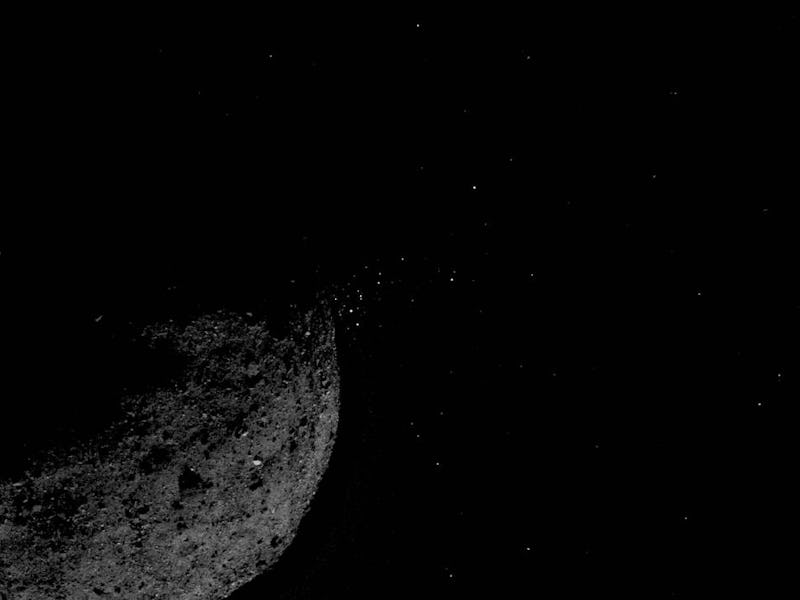Bennu's Unexpected Eruptions Are "Biggest Surprise" of NASA Scientist's Career

NASA scientists have been carefully studying photos of the near-Earth asteroid Bennu ever since the spacecraft OSIRIS-REx began orbiting it on the last day of 2018. During their most recent investigation, they discovered something that Dante Lauretta, Ph.D., the principal investigator on the OSIRIS-REx project, called “one of the biggest surprises of my scientific career.”
Bennu the asteroid spits out plumes of particles. And it does so often.
"The discovery of plumes is one of the biggest surprises of my scientific career."
“The discovery of plumes is one of the biggest surprises of my scientific career,” said Lauretta. In a teleconference for reporters on Tuesday, he presented the photo below, a composite of two different images: The short exposure shows the asteroid surface, and the long exposure shows a series of bright pixels. Those specks of light are particles, some of which are just a few centimeters in diameter, and others that are tens of centimeters in size.
Since they started watching for these events on January 6, the OSIRIS-REx mission team said Bennu spit out rubble 11 times, and three of those events were “major,” said Rich Burns, the mission’s project manager, in the teleconference.
Bennu ejecting particles from its surface on January 19. This was a very unexpected event.
Its propensity for coughing up these particles, many of which end up in orbit around Bennu or fall back down onto its surface, puts the asteroid in the class of ‘active asteroids,” said Lauretta.
"Bennu has a continuous population of particles raining down on it."
“Bennu has a continuous population of particles raining down on it,” said Lauretta.
There’s a lot we don’t know about active asteroids. All we know is that they “eject dust, producing transient, comet-like comae and tails,” researchers wrote in the textbook Asteroids IV. “The causes of activity in this newly-identified population,” they wrote, “are many and varied.” They have some theories, but they note: “These processes were either unsuspected or thought to lie beyond the realm of observation before the discovery of asteroid activity.”
Lauretta said the team doesn’t know the mechanism behind Bennu’s eruptions right now and is still trying to “make sense of what’s going on with this asteroid.”
As the photo suggests, Bennu can spit its plume of particles pretty far. Though that is surprising and exciting, it’s not great news for the OSIRIS-REx spacecraft, which needs to get within spitting distance — 1.61 kilometers — of Bennu to collect samples of its pristine regolith.
A view of Bennu's southern hemisphere, snapped on March 7. It's unexpectedly covered in huge boulders, like the 24-foot stone just left of center.
Within a day of the discovery, said Burns, the team did a “quick turnaround safety assessment” to find out the likelihood that OSIRIS-REx, which took two years to travel to Bennu, would get hit in the face. Fortunately, this assessment showed that the spacecraft was safe.
The team announced several other surprising discoveries about Bennu in the teleconference, including an unexpected number of large boulders on its surface and a rapid increase in its rotation rate. Lauretta chalks up the latter to the YORP (Yarkovsky-O’Keefe-Radzievskii-Paddack) effect, which explains how Bennu’s interaction with sunlight could make it spin faster.
This is an “incredibly exciting time,” said Lauretta of the research on Bennu. They hope that OSIRIS-REx will be nimble enough to pick its way through Bennu’s newly discovered boulders to collect samples, which it will bring back to Earth by 2023. Because Bennu was formed in the early days of the Solar System and has largely been unheated and unprocessed since then, researchers call it a “time capsule” — one that could offer a glimpse into the chemicals that existed when life began.